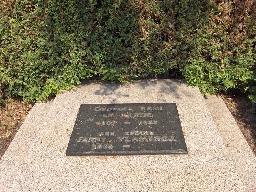Hergé |
| COMIC ARTIST (BELGIUM) |
|
BORN 22 May 1907, Etterbeek - DIED 3 Mar 1983, Brussel: Cliniques Universitaires Saint-Luc, Woluwe-Saint-Lambert BIRTH NAME Rémi, Georges Prosper GRAVE LOCATION Brussel: Dieweg begraafplaats, Ukkel |
|
Hergé was born Georges Rémi in Etterbeek, Brussels. He went to school in Brussels during the German occupation and in 1920 he entered Saint-Boniface, a school where the teachers were Catholic priests. In 1922 his first drawings were published in the school paper and in 1924 he started using the name Hergé. From 1925 onwards he worked for "Le XXe Siècle", edited by abbé Norbert Wallez. In 1929 his comic strip "Tintin in the Land of the Soviets" was published in "Le Petit Vingtième". The young reporter Tintin would make him famous. In 1930 he started "Quick et Flupke". The second Tintin story was "Tintin in the Congo". In 1932 he married Germaine Kieckens, who worked as a secretary for Wallez. They had no children. After Belgium was occupied by German troops in 1940 "Le Petit Vingtième" disappeared. He published his new Tintin story "Le Soir", a newpaper that was controlled by the Germans. During the war he produced several Tintin stories and introduced Captain Haddock and Professeur Tryphon Tournesol. In "The Shooting Star" two crews tried to reach a meteorite. One of the crews was 'European', the other 'American' and financed by Jews. Worse, Tintin flew in a German plane. After the war he was accused of collaboration and he was arrested several times and interrogated. He claimed that he had just worked like everybody else. He admitted that he had believed that democracy might be replaced by a new order. Although he hadn't supported the nazis actively he was no longer allowed to do newspaper work. Together with the artist E.P. Jacobs and his assistant Alice Devos he reworked his old Tintin stories in color during the next years. In 1946 resistance fighter Raymond Leblanc came to his aid and together they started the new magazin Tintin. After Hergé refused to give Jacobs public credits for his contrubution the latter started his own series for the magazine, "Blake and Mortimer". He had suffered from the way he was treated after the war and around 1950 he had two nervous breakdowns. In 1950 the Hergé Studio's were founded to decrease his workload. From then on Bob de Moor helped him with Tintin. At the end of the 1950s his marriage with Germaine failed and he fell in love with Fanny Vlamynck, a colouring artist at the Hergé Studio's. He suffered from nightmares and used this experience in "Tintin in Tibet". In 1960 he left Germaine, but only in 1977 they divorced and he married Fanny during the same year. In 1971 he visited the USA and in 1973 he travelled to Taiwan. During the last years of his life he was seriously ill and weekly blood transfusions were necessary. He contracted HIV and died in 1983. He was buried at the old Cemetery at the Dieweg in Ukkel, Brussels. It had been closed for new burials for years, but an exception was made for Hergé. After his death Fanny became the owner of the rights to Tintin. In 1993 she married the young Nick Rodwell, who ran a Tintin shop in Covent Garden, London. Because of their very strict control of the use of the image of Tintin they weren't popular with everyone. However, Fanny financed the Tintin museum at Louvain-la-Neuve that opened in 2009. |
Sources • Hergé - Wikipedia • Fanny Rodwell — Wikipédia |



